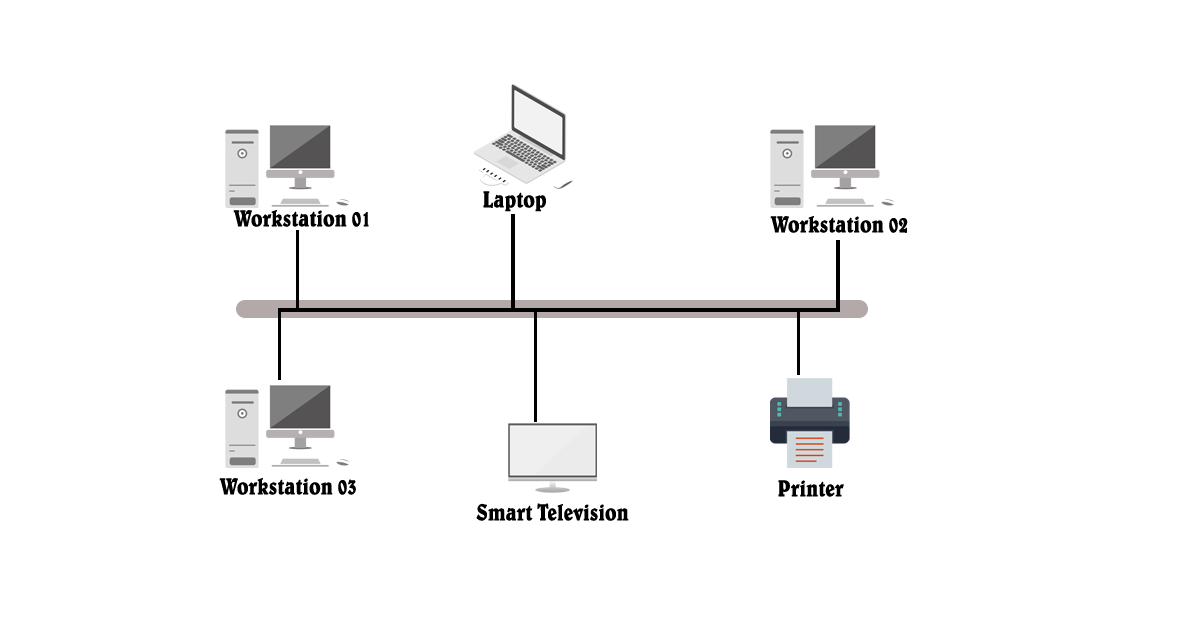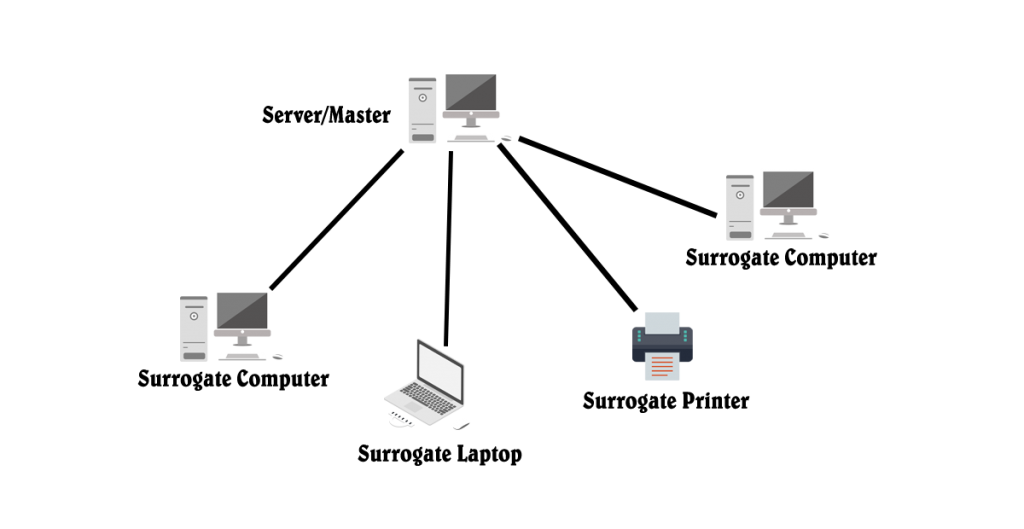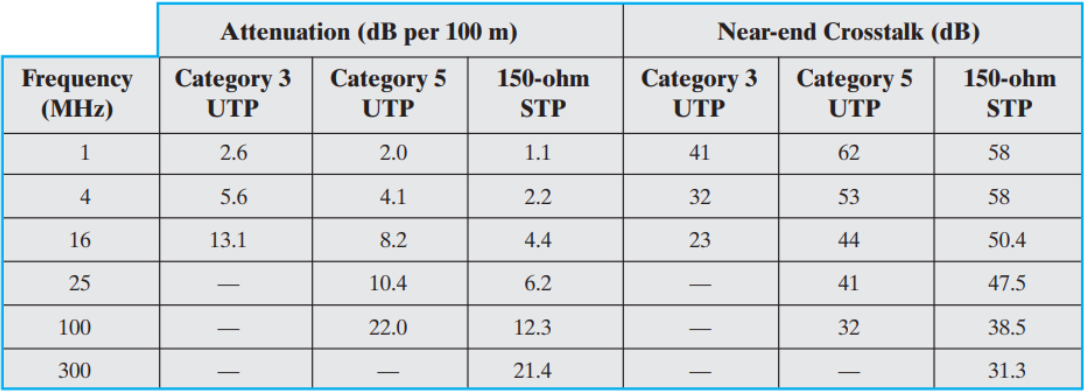A computer network is a group of computers that use a set of common communication protocols over digital interconnections for the purpose of sharing resources located on or provided by the network nodes. The interconnections between nodes are formed from a broad spectrum of telecommunication network technologies, based on physically wired, optical, and wireless radio-frequency methods that may be arranged in a variety of network topologies.
Fig : A Computer Network

Computer Network Models
There are several configuration models that form a computer network. The most common of these are the centralized and distributed models. In a centralized model,several computers and devices are interconnected and can talk to each other.
Fig : A centralized model
 Fig : A distributed model
Fig : A distributed model 
Computer Network Types
Computer networks come in different sizes. Each network is a cluster of network elements and their resources. The size of the cluster determines the network type.
Local Area Networks (LANs)
A computer network with two or more computers or clusters of network and their resources connected by a communication medium sharing communication protocols and confined in a small geographical area, such as a building floor, a building, or a few adjacent buildings, is called a local area network (LAN).

Wide Area Networks (WANs)
A wide area network (WAN), on the other hand, is a network made up of one or more clusters of network elements and their resources, but instead of being confined to a small area, the elements of the clusters or the clusters themselves are scattered over a wide geographical area as in a region of a country or across the whole country, several countries, or the entire globe like the Internet.
Metropolitan Area Networks (MANs)

Between the LAN and WAN, there is also a middle network called the metropolitan area network (MAN) because it covers a slightly wider area than the LAN but not so wide as to be considered a WAN.
Personal Area Network(PANs)
A PAN is network of connected devices used by one person. It allows devices such as computers, tablets, smartphones, and smartwatches to communicate with each other.
“Smartphone tethering” is a common type of PAN, in which a laptop or other device connects to the Internet through a smartphone’s cellular data connection. If your mobile plan allows it, you can set up your smartphone as a “mobile hotspot” which makes it function like a wireless router that is connected to the Internet. You can then connect to the smartphone from your computer or tablet like you would connect to a Wi-Fi router. Tethering may take place over Bluetooth, Wi-Fi, or USB depending on the device.
Data Communication Media Technology
The performance of a network type depends greatly on the transmission technology and media used in the network. Let us look at these two.
Transmission Technology
The media through which information has to be transmitted determine the signal to be used.
Some media permit only analog signals. Some allow both analog and digital. Therefore, depending on the media type involved and other considerations, the input data can be represented as either digital or analog signal.
Analog Encoding of Digital Data
Recall that digital information is in the form of 1s or 0s. To send this information over some analog medium such as the telephone line, for example, which has limited bandwidth, digital data needs to be encoded using modulation and demodulation to produce analog signals.
-
Amplitude modulation represents each binary value by a different amplitude of the carrier frequency. The absence of or low carrier frequency may represent a 0,and any other frequency then represents a 1. But this is a rather inefficient modulation technique and is therefore used only at low frequencies up to 1,200 bps in voice grade lines.
-
Frequency modulation also represents the two binary values by two different frequencies close to the frequency of the underlying carrier. Higher frequencies represent a 1 and low frequencies represent a 0. The scheme is less susceptible to errors.
-
Phase shift modulation changes the timing of the carrier wave, shifting the carrier phase to encode the data. A 1 is encoded as a change in phase by 180°, and a 0 may be encoded as a 0 change in phase of a carrier signal. This is the most efficient scheme of the three, and it can reach a transmission rate of up to 9,600 bps.
Digital Encoding of Digital Data
In this encoding scheme, which offers the most common and easiest way to transmit digital signals, two binary digits are used to represent two different voltages.
One may wonder why go through the hassle of digital encoding and transmission. There are several advantages over its cousin, analog encoding. These include the following:
- Plummeting costs of digital circuitry.
- More efficient integration of voice, video, text, and image.
- Reduction of noise and other signal impairment because of use of repeaters.
- Capacity of channels is utilized best with digital techniques.
- Better encryption and hence better security than in analog transmission.
Multiplexing of Transmission Signals
Quite often during the transmission of data over a network medium, the volume of transmitted data may far exceed the capacity of the medium. Whenever this happens, it may be possible to make multiple signal carriers share a transmission medium. This is referred to as multiplexing.
-
-
- There are two ways in which multiplexing can be achieved:
- time-division multiplexing (TMD)
- frequency-division multiplexing (FDM)
Transmission Media
As we have observed above, in any form of communication, there must be a medium through which the communication can take place. So network elements in a network need a medium in order to communicate.
Network transmission media can be either Guided and Unguided.
Guided Transmission Media
Guided media, which are those that provide a conduit from one device to another, include twisted-pair cable, coaxial cable, and fiber-optic cable. A signal traveling along any of these media is directed and contained by the physical limits of the medium.
Twisted Pair
-
- The least expensive and most widely used guided transmission medium is twisted pair.
- A twisted pair consists of two conductors (normally copper), each with its own plastic insulation, twisted together.
- One of the wires is used to carry signals to the receiver, and the other is used only as a ground reference.
- Twisted pair comes in two varieties: unshielded and shielded.
- The most common twisted-pair cable used in communications is referred to as unshielded twisted-pair (UTP).
- STP cable has a metal foil or braided mesh covering that encases
each pair of insulated conductors.
Comparison of Shielded and Unshielded Twisted Pair

Coaxial Cable
- Coaxial cable (or coax) carries signals of higher frequency ranges than those in twisted-pair cable, in part because the two media are constructed quite differently.
- Instead of having two wires, coax has a central core conductor of solid or stranded wire (usually copper) enclosed in an insulating sheath, which is, in turn, encased in an outer conductor of metal foil, braid, or a combination of the two.
- The outer metallic wrapping serves both as a shield against noise and as the second conductor, which completes the circuit.
Fiber-Optic Cable
- A fiber-optic cable is made of glass or plastic and transmits signals in the form of light.
- Fiber-optic cable are used for different applications, for example, long distance telecommunication, or providing a high-speed data connection between different parts of a building.
Frequency Utilization for Fiber Applications
Unguided Transmission Media
Satellite Microwave Transmission
- Transmitting data using electro radio waves through free space is called satellite communication.
- In satellite communications there are many transponders called frequency band.
Usages of satellite microwave :
- Distributing signal over television channel.
- Telephone transmission over long distance.
- Networks that are used for private business.
Radio wave transmission
- Its broadcast signals only in single direction which is in contrast with the microwave transmission that broadcast in both directions.
- One of the advantage of radio wave transmissions is that it does not require any antennas.
- Radio waves are propagated using ground wave and sky wave.
Usages of radio microwave :
- Radio waves are generally used for transmitting sound, images that include bothvoice signal and television signals. These signals are converted into electrical signals by performing modulation, the modulated signals are amplified and transmitted to antennas that converts the electrical signals to electromagnetic signals that are used for radiation into ionosphere.
- Radio waves are used for directing the movement of ships and aircraft with the
help of radio compass or radio time signals.
Terrestrial microwave transmission
- Microwave transmission make use of microwave link for transmitting information.
- Terrestrial microwave use large height antennas to cover long sight distances. It is
more suitable for line-of-sight transmission link.
Usages of Terrestrial microwave transmission:
- Microwave relay links are used for television and telephone transmission.
- Microwave act as a backbone carrier in cellular network.
- They are used both for larger heave telecommunication services as well as short
heave by-pass applications.
Infrared wave transmission
- Infrared waves are electromagnetic waves that have the wavelength longer than visible light but shorter than radio wave.
- One of the advantage of infrared waves over other unguided media is that it cannot pass through walls due to which the security is more and the impairment such as interference is not present.
…
Did you get some knowledge about Computer Network? Please drop your comments below.
Next we’ll post about Network Topologies & Network Protocols & Network Connecting Devices.